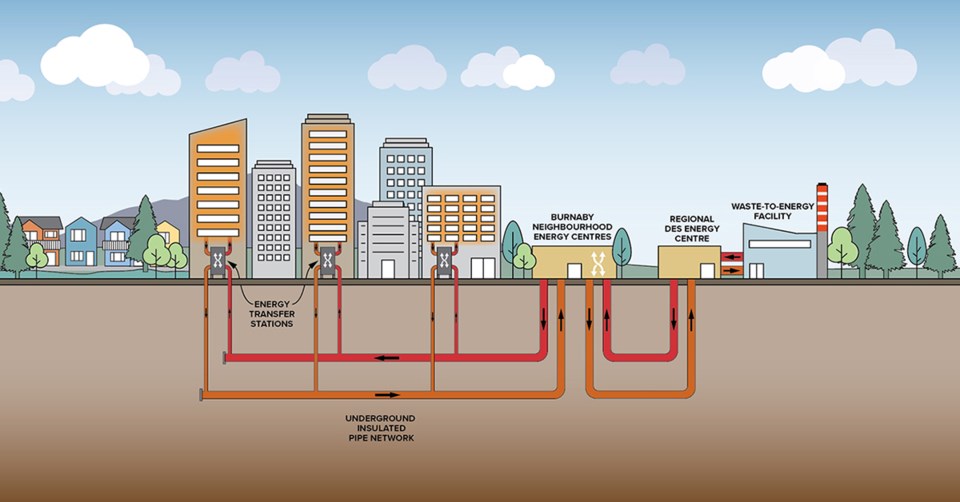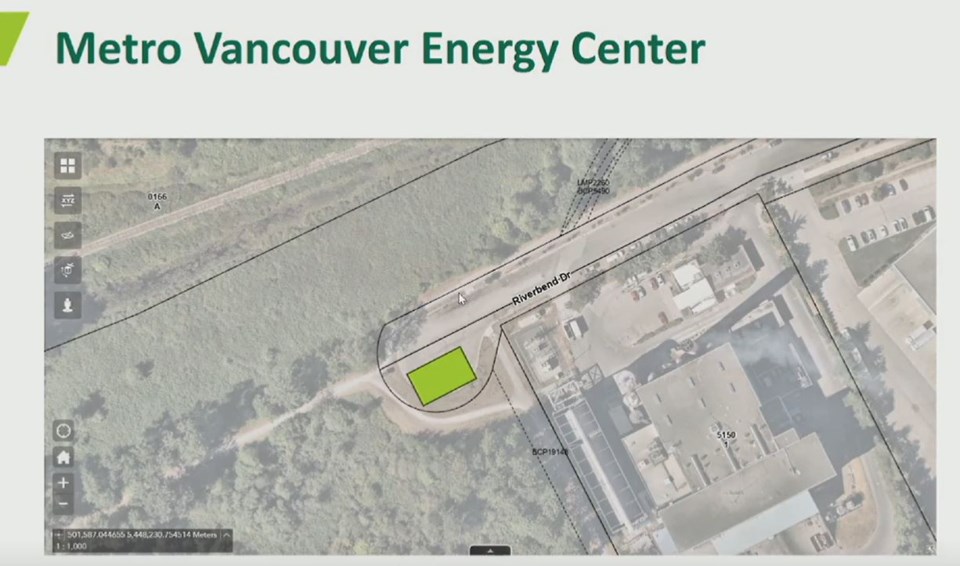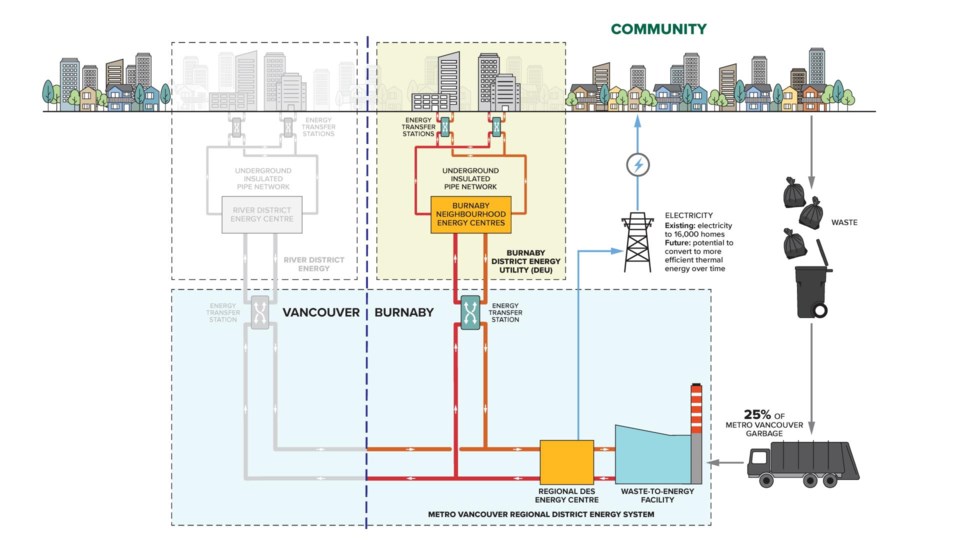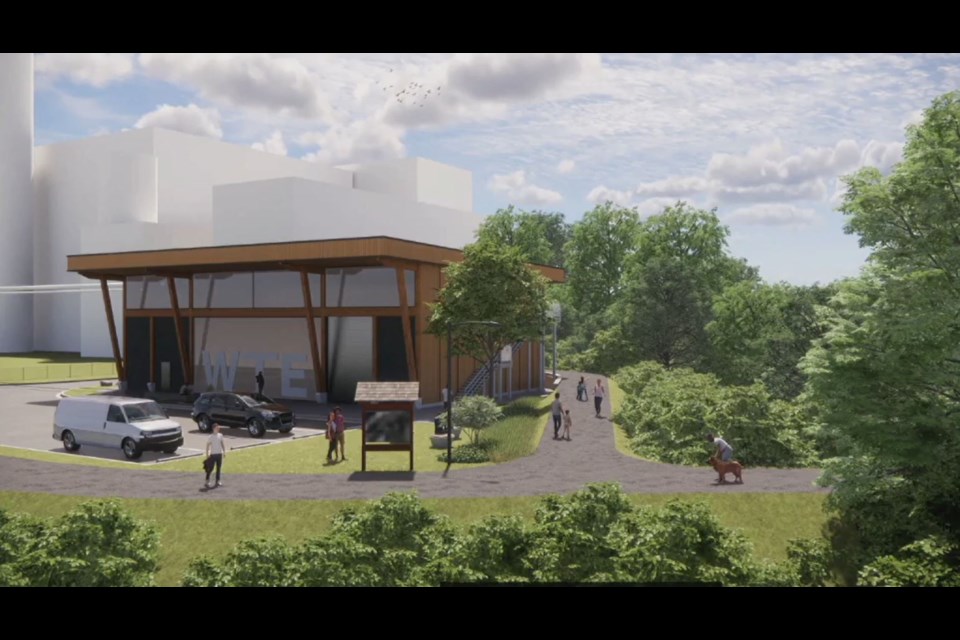Burnaby has awarded the first major contract for its massive garbage-powered district energy system.
The utility system will power homes and businesses across South Burnaby.
Council approved a $7.6-million contract to ISL Engineering & Land Services Ltd. and FVB Energy Inc. at a meeting April 15 for the detailed design and procurement of the project’s first phase.
Increases to the contract are expected as the project progresses.
The future District Energy Utility will take waste heat (steam) from Metro Vancouver’s existing Waste-to-Energy Facility, an incinerator in the Big Bend area, and convert it into hot water.
The hot water will be pumped through underground pipes to Neighbourhood Energy Centres and then through more pipes to homes and businesses in Metrotown and Edmonds.
New residential buildings will swap their roof-based mechanical equipment for large refrigerator-sized energy transfer stations in the basement that exchange the thermal energy from the pipes to the building’s heating system.

The project is part of the city’s climate action goals to reduce greenhouse gas emissions – around 38 per cent of Burnaby’s carbon emissions come from buildings.
The city expects to reduce about 82 per cent of CO2 equivalent annually, about 22,400 tonnes of CO2e, when compared to business as usual.
The total project budget for Phase 1, based in Metrotown, is $200 million, according to bid documents released in January; the city has included $25.5 million of the total estimated capital costs in the current five-year financial plan.
Metro Vancouver’s main facility will be the energy centre that captures the waste heat from the incinerator (which has operated since 1988) and turns it into hot water, the city’s general manager of lands and facilities, James Lota, told council.
The energy centre will be contained in the cul-de-sac at the end of Riverbend Drive adjacent to Fraser Foreshore Park, right next door to the Waste-to-Energy Facility.
“It’s fully outside the park area,” Lota said, adding the facility will not impact the park.
The city plans to enhance the area with public washrooms and an environmental education centre to hold classes to learn about the district energy system and the park.

Coun. Alison Gu said district energy systems are part of the solution for concerns around BC Hydro’s supply of electricity.
She advocated for similar systems throughout the Lower Mainland.
“Waste heat is everywhere,” Gu said. “And we don’t think about it on a day-to-day basis necessarily, but everything from commercial grocery store refrigerators to ice rinks to data centres … We can capture that waste heat and use it to be able to heat water and space and limit the amount of electricity that we are relying on to power our buildings.”
She said the system can mean reducing investment needed for costly electrical grid upgrades and provide everyday benefits like freeing up building roofs for community gardens and shared space.
Next steps
The full build-out of the system is expected in about 20 years; phase 3 of the development wraps up in 2050.
The next phase of the project (Phase 1 runs from 2025 to 2030) will include planning and designing the initial build-out of the Metrotown and Edmonds “District Energy nodes” with both Neighbourhood Energy Centres and pipes.
The project team will now validate the business case, refine the system in the service areas where initial customers are concentrated and finalize agreements with Metro Vancouver.
Burnaby is currently negotiating with Metro Vancouver over the heat supply agreement and how to use the city streets for Metro infrastructure.
The city will apply to the province for incorporation of the district energy corporation.
Bid documents released as part of the request for proposals estimated construction on the first phase at Metrotown could begin (subject to government approvals) by September 2024 and be “substantially” complete by 2027.
The city estimates the DEU could start operations by 2026.
Staff will report back to council, including with a target cost for Phase 1, later this year.






